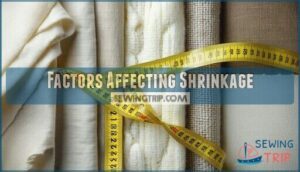This site is supported by our readers. We may earn a commission, at no cost to you, if you purchase through links.
 Natural fibers shrink the most when you wash them.
Natural fibers shrink the most when you wash them.
Cotton can shrink up to 20%, while wool and linen also contract substantially.
These fabrics contain fibers that relax and tighten when exposed to heat and moisture.
Synthetic fabrics like polyester and nylon resist shrinkage because they’re engineered to maintain their shape.
Fabric blends fall somewhere in between, depending on their natural fiber content.
The weave, quality, and manufacturing process also affect how much a fabric will shrink.
Pre-shrunk fabrics have already undergone controlled shrinking to minimize future changes.
Understanding which materials are shrinkage-prone helps you make smarter laundry choices and protect your favorite clothes from unexpected size changes.
Table Of Contents
Key Takeaways
- Natural fibers like cotton, wool, and linen shrink the most—cotton can shrink up to 20% while synthetic fabrics like polyester resist shrinkage because they’re engineered to maintain their shape.
- You’ll get the worst shrinkage when you combine hot water, heat drying, and agitation—cold water washing and air-drying are your best defenses against unwanted size changes.
- Fabric blends fall somewhere in between pure natural and synthetic materials—a 50/50 cotton-polyester blend typically shrinks only 1-3% compared to pure cotton’s 3-7%.
- Pre-washing your fabrics before sewing projects prevents disappointing surprises, and you can partially reverse shrinkage by soaking clothes in lukewarm water with conditioner and gently stretching while damp.
Fabric Shrinkage Basics
You’ll encounter shrinkage with most fabric types, but natural fibers like cotton and wool shrink substantially more than synthetic materials.
Understanding which fabrics are prone to shrinking helps you choose the right care methods and avoid costly laundry mistakes, by considering complete concepts and natural fibers.
Natural Fibers
Natural fabrics come straight from nature’s own textile factory.
Cotton shrinkage hits hardest at 3-7%, while wool can shrink dramatically when exposed to heat and moisture.
Heat and moisture turn natural fibers into shrinking nightmares.
These fiber origins create natural durability but also vulnerability.
Linen and silk offer eco-friendliness with excellent dye absorption and texture variety, though they’re still prone to fabric shrinkage during washing.
To mitigate this, consider preshrinking wool fabric before sewing to achieve better results.
Synthetic Fibers
Unlike natural fibers, synthetic fabrics resist shrinkage better.
However, polyester shrinkage and acrylic shrinkage can still occur under high heat.
Performance fabrics and microfiber concerns affect care methods differently.
- Polyester – Minimal shrinking, but heat-sensitive during drying
- Nylon – Excellent shape retention with proper washing temperatures
- Acrylic – Moderate shrinkage risk when exposed to hot water
- Spandex/Elastane – Heat damages elasticity, causing permanent distortion
Fabric Blends
Fabric blends combine natural and synthetic fibers, creating materials with mixed shrinkage behaviors.
Cotton-polyester blends typically shrink less than pure cotton due to polyester’s stability. However, fabrics that shrink still pose challenges—wool shrinkage remains significant in wool-blend materials, while linen shrinkage affects linen-cotton combinations.
Rayon shrinkage can occur even in synthetic blends. Blend durability improves with proper care, though blend cost varies.
Blend applications span clothing to home goods, offering blend comfort and moderate blend breathability.
What Fabrics Shrink Most
Cotton leads the shrinkage pack, losing 3-7% of its size after the first wash. Knit fabric varieties shrink even more than woven cotton due to their loose structure.
Cotton’s the worst offender—expect your favorite shirt to shrink up to 7% after that first wash.
Wool shrinkage can be dramatic—up to 20% when exposed to heat and moisture. Linen shrinkage ranges from 4-10%, especially if manufacturers haven’t pre-shrunk the material.
Rayon shrinkage hits hard at 8-10% in warm water, making shrinkage testing critical before sewing projects. Bamboo fabrics follow close behind at 6-8% unless they’re treated or blended.
Washing impact varies substantially—the combination of heat, moisture, and agitation creates the perfect storm for dimensional changes.
Fabrics that shrink most share common traits: natural fibers absorb water readily, causing individual threads to swell and contract. The shrinkage percentage you’ll see depends on fiber type, weave structure, and manufacturing processes.
Woolens shrinkage occurs because protein fibers felt together when agitated, while cellulose fibers like cotton simply contract as they dry. To avoid this, consider that cold water washing helps to reduce fiber contraction.
Factors Affecting Shrinkage
Several key factors determine how much your fabrics will shrink beyond just the material type.
The weave structure, fiber quality, and any pre-treatments applied during manufacturing all play vital roles in whether your favorite shirt stays the same size after washing, considering the overall fabric quality.
Fabric Type and Composition
Understanding fabric composition helps you predict shrinkage before it happens.
Cotton shrinks up to 20%, while polyester stays put at under 2%.
Fiber blends offer a middle ground—cotton-polyester mixes typically shrink 2-5%.
Knit fabrics stretch and contract more than woven fabric due to their flexible structure.
Material durability and weave structure directly impact how much your garments will change size after washing, considering factors like cotton-polyester mixes.
Weave and Quality
Weave tightness determines how much your fabric will shrink.
Loose weaves allow more movement between threads, creating space for textile shrinkage during washing. Tight weaves hold threads firmly together, reducing shrinkage potential.
Knit fabrics stretch more than woven fabric due to their loop structure, making them shrink unpredictably.
Higher thread count and fabric quality from careful material sourcing improve fabric durability and reduce unwanted size changes, which is related to the overall fabric quality.
Stretching and Treatments
Manufacturing processes and chemical finishes substantially impact your fabric’s shrinkage potential.
When fabrics experience excessive mechanical stretching during production, you’re setting yourself up for disappointment after washing.
Here’s what affects fabric relaxation and tension release:
- High-tension weaving creates stressed fibers that shrink up to 8% during first wash
- Knit distortion from stretching makes fabrics lose shape and dimensional stability
- Anti-stretch finishes like mercerization reduce cotton shrinkage by 50%
- Heat treatment and blocking techniques help preshrinking fabric before sewing
Understanding textile shrinkage means recognizing that preventing shrinkage starts at manufacturing, not just your laundry room.
Specifically, fiber composition impacts how much a fabric will shrink.
Fabrics Resistant to Shrinkage
Looking for fabrics that won’t leave you with a wardrobe full of shrunken surprises?
You’ll be relieved to know that certain materials resist shrinkage better than others, giving you peace of mind when washing and caring for your clothes.
Cotton Blends
Blending cotton with synthetic fibers dramatically reduces shrinkage rates. Poly-cotton blends deliver blend advantages by combining cotton’s comfort with polyester’s stability.
These washing blends maintain shape better than pure cotton fabrics, showing less than 2% shrinkage after repeated washes.
| Blend Type | Shrinkage Rate |
|---|---|
| 65/35 Cotton-Polyester | Under 2% |
| 50/50 Cotton-Polyester | 1-2% |
| Cotton-Spandex | Under 3% |
| Cotton-Modal | 2-3% |
| Cotton-Rayon | 2-4% |
This blend durability makes ironing blends easier while preventing shrinkage concerns that plague pure cotton materials, ensuring better maintenance of the fabric’s original shape.
Leather and Suede
Leather and suede offer excellent fabric shrinkage resistance compared to natural fabric types.
Tanned leather maintains its size through cross-linked protein structures that prevent dimensional changes during cleaning methods.
Suede textures remain stable but may stiffen when exposed to moisture.
Proper fabric care for these leather types involves specialized cleaning methods rather than traditional washing fabrics approaches.
Patent leather with water-resistant finishes shows superior durability factors.
When considering ethical sourcing, these materials provide long-lasting fabric properties that resist the shrinkage issues common in other fabric types.
However, note that suede can shrink if exposed to excessive heat or water.
Preventing Fabric Shrinkage
You can protect your fabrics from unwanted shrinkage with the right washing and drying methods.
Smart care techniques will keep your clothes fitting properly and looking their best wash after wash.
Air-Drying Techniques
Air-drying keeps fabric properties intact by avoiding heat damage that causes shrinkage.
Choose ideal airflow areas away from direct sunlight exposure, which can fade colors and weaken fibers.
Lay drying fabrics flat or hang them properly to maintain fabric orientation and prevent stretching.
Consider using an efficient drying solution to optimize the process.
Check drying time regularly, reshaping items while damp for avoiding wrinkles and preserving original dimensions, which is crucial for maintaining the original dimensions.
Pre-Washing for Sewing Projects
Pre-washing cotton and other natural fabrics before sewing prevents unwanted surprises in your finished project.
Use the same water temperature and detergent you’ll use for the completed garment. This preshrinking step reveals how much fabric shrinks, letting you adjust pattern pieces accordingly.
Many sewers find it useful to explore fabric prewash options.
Follow washing instructions carefully, then air-dry or use appropriate drying methods.
Iron the fabric smooth before cutting your pattern pieces to ensure a smooth finish and to make the sewing process easier, which is a critical step in achieving professional results.
Special Care for Delicate Fabrics
Delicate fabrics need gentle handling to prevent damage and maintain their beauty. Handle these materials like precious items – they reward careful treatment with lasting quality.
- Silk Washing: Use cold water and mild detergent, never wring or twist the fabric. For best results, consider using a specialized silk wash.
- Lace Handling: Place in mesh bags during washing to protect intricate patterns from snagging.
- Velvet Care: Steam instead of ironing to maintain texture and prevent crushing.
- Embellishment Protection: Turn garments inside out before washing to shield beads and sequins.
Frequently Asked Questions (FAQs)
What fabrics do not shrink?
Synthetic fabrics like polyester, nylon, acrylic, and spandex resist shrinking because they’re engineered with stable fibers.
Blends containing high percentages of synthetics also maintain their size better than pure natural fibers, which can be a significant advantage in terms of durability.
What material is most likely to shrink?
Cotton fabric shrinks the most, typically 3-7% after washing.
Knit cotton shrinks more than woven cotton due to its looser structure.
Heat, moisture, and agitation cause cotton’s fibers to contract substantially.
Does 65% cotton and 35% polyester shrink?
Yes, 65% cotton and 35% polyester blends will shrink, but less than pure cotton.
You’ll see about 2-4% shrinkage after the first wash since cotton fibers contract when exposed to heat and moisture, while polyester stays stable.
Does 50% cotton and 50% polyester shrink in the dryer?
A 50/50 cotton-polyester blend will shrink minimally in the dryer. The cotton fibers may shrink slightly, but polyester’s stability reduces overall shrinkage to about 1-3%, much less than pure cotton.
How much do vintage fabrics shrink?
Vintage fabrics typically shrink 5-15% depending on their fiber content and age.
Natural fibers like cotton and wool shrink more than synthetics.
Always test a small piece first before washing your entire vintage piece.
Does fabric softener prevent shrinkage?
Fabric softener doesn’t prevent shrinkage—it works by coating fibers to make them feel softer.
But it won’t stop cotton or other natural fabrics from shrinking when exposed to heat and moisture during washing.
Can you unshrink clothes after washing?
You can partially reverse shrinkage by soaking clothes in lukewarm water with hair conditioner or baby shampoo, then gently stretching while damp and air-drying flat.
Do dark colors shrink more than light?
Like comparing twins dressed differently, color intensity doesn’t affect shrinkage rates. Your fabric’s fiber content and weave structure determine shrinkage, not whether it’s navy or cream colored.
Which washing machine settings cause most shrinkage?
High heat settings combined with hot water and aggressive agitation create the perfect storm for shrinkage.
You’ll see maximum fabric damage when using hot wash cycles with high-speed spins and heated drying.
Conclusion
Statistics show that untreated cotton can shrink up to 20% in a single wash cycle.
Understanding what fabrics shrink helps you protect your wardrobe investments. Natural fibers like cotton, wool, and linen shrink most due to their fiber structure.
Synthetic materials resist shrinkage better. You can prevent damage by using cold water, gentle cycles, and air-drying methods.
Pre-shrunk fabrics offer added protection. Smart washing choices keep your clothes fitting perfectly for years.
- https://www.onlineclothingstudy.com/2018/08/average-shrinkage-percentage-of.html
- https://mypacklove.com/blog/heat-transfer-labels/what-is-shrinkage-understand-causes-prevent-and-care-tips/
- https://recovo.co/en/blog/article/what-kind-of-fabrics-shrink-when-washed-and-how-to-avoid-it
- https://yorkshirefabricshop.com/blogs/knowledge/why-does-fabric-shrink
- https://www.delinum.com.au/blogs/de-linum-blog/will-linen-fabric-shrink-how











